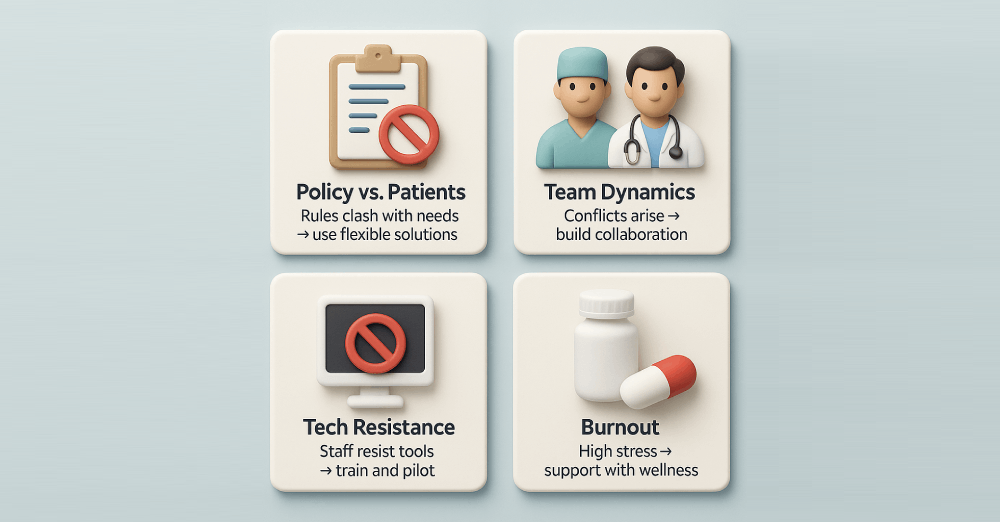Healthcare is changing rapidly. Patients today expect the same quality of service they receive from retail or finance sectors. This shift places new pressure on customer service managers. Their role is not only about overseeing support teams. It is about bridging patient needs with organizational strategy, balancing empathy with data, and ensuring every interaction builds trust.
Research confirms the connection between communication quality and patient adherence. Poor communication leads to misunderstandings, low compliance with treatment, and reduced trust in institutions (NIH). A skilled service manager can directly influence outcomes by improving how information flows between patients, staff, and systems.

Core Duties That Define Patient-Centered Service
Customer service managers oversee systems that define the patient experience. They manage policies, lead teams, and align service processes with medical standards. The following duties are central:
- Setting clear service standards
Consistency is vital in healthcare. Patients want predictable answers and clear instructions. Managers create policies that ensure every staff member delivers information in the same way. - Training and professional development
Ongoing education helps staff adapt to medical updates and new technologies. Training on communication reduces misunderstandings, which are a major source of patient dissatisfaction. - Performance monitoring
Metrics like response times, first-contact resolution, and satisfaction scores reveal service quality. Regular analysis identifies problems before they escalate. - Feedback integration
Patient feedback systems provide real-time data. Managers use this data to update policies and adjust team strategies.
These core tasks may look operational, but they carry ethical weight. Patients rely on accurate and timely communication for their health decisions.

Problem-Solving at the Frontline
Escalated issues test both the technical knowledge and emotional intelligence of managers. A delayed test result, an unclear insurance policy, or a billing mistake can create immediate frustration. If not handled properly, these issues can damage trust and increase the risk of patient attrition. Managers must resolve such cases quickly, without alienating patients or breaching policies.
Studies confirm that effective resolution directly lowers complaint rates and improves trust in healthcare institutions (CDC). Patients who feel heard are more likely to return and to follow medical recommendations.
Key Approaches to Resolution
Successful managers rely on several consistent practices:
- Active listening: Patients must feel their concerns are taken seriously. Interrupting or rushing them often escalates tension. Listening fully allows managers to capture both the facts and the emotions behind the complaint.
- Clear explanations: Medical and administrative terms are simplified. For instance, instead of saying “authorization pending,” managers can explain “your insurer has not yet approved payment, and we are following up.” This clarity reduces anxiety.
- Follow-ups: After resolving an issue, confirmation calls or short messages ensure satisfaction. Even a brief follow-up signals accountability and care.
Applying Emotional Intelligence
Beyond protocols, emotional intelligence is crucial. Managers who show empathy can de-escalate tense situations. For example, acknowledging a patient’s frustration over a billing error before explaining the solution often changes the tone of the interaction. This combination of empathy and professionalism demonstrates that the institution values the patient as more than a case number.
Balancing Policy and Flexibility
One of the hardest parts of problem-solving is balancing strict policies with individual needs. A patient might request a refund beyond the official deadline or seek access to test results faster than the system allows. Skilled managers find creative solutions—such as partial credits, expedited handling, or alternative options—that respect policies while meeting patient expectations. This flexibility prevents conflicts from becoming formal complaints.
Building Team Standards
Managers also set the standard for frontline staff. By handling difficult cases with patience and professionalism, they create examples for the team to follow. Regularly reviewing complex cases during staff meetings helps agents learn best practices and prepares them for future challenges.
Turning Crises into Trust-Building Opportunities
What begins as a negative incident can become a loyalty-building moment. A patient frustrated by a lost appointment may become more loyal if the manager resolves the issue quickly, apologizes sincerely, and provides a practical solution. This transformation—from problem to trust—is one of the most powerful outcomes of skilled problem-solving.

Technology as a Force Multiplier
Technology is reshaping customer service in healthcare. Managers now use AI systems, CRM tools, and analytics dashboards to reduce delays and improve accuracy. But the main challenge remains integration without losing empathy.
Automation and AI
Chatbots and virtual agents reduce response times for routine queries. They handle scheduling, billing information, or FAQs. Platforms like Graphlogic Generative AI & Conversational Platform enable conversational automation that feels natural and supports multiple channels.
Yet, managers must balance efficiency with the human touch. Automation should not replace empathy in sensitive interactions, such as delivering medical results or discussing treatment costs.
CRM and Analytics
Centralized platforms like Salesforce or Zendesk give staff a unified patient history. This prevents repetition, as patients do not need to explain the same issue multiple times. Analytics tools measure performance trends, allowing managers to detect service bottlenecks.
A study from the Agency for Healthcare Research and Quality (AHRQ) confirms that well-integrated data systems reduce medical errors and improve patient safety.
Accessibility Tools
Accessibility is another critical area. Speech technologies provide inclusive communication for patients with impairments. The Graphlogic Text-to-Speech API enables support teams to deliver voice-enabled updates and reminders, extending access for visually impaired or multilingual patients.
Common Challenges in Healthcare Service Management
The role of a customer service manager comes with unique challenges. Four stand out:
- Policy conflicts with patient expectations
Strict rules may clash with patient needs. For example, refund policies or appointment limits may frustrate patients. Managers must negotiate solutions that protect both sides. - Team dynamics
Support teams often include individuals with different stress tolerance and motivation. Managers must address conflicts, encourage collaboration, and create inclusive environments. - Resistance to new technologies
Adopting new systems is rarely smooth. Staff may resist automation or CRM tools. Training programs and pilot rollouts reduce this friction. - Stress and burnout
The emotional load of healthcare support is high. Burnout leads to turnover and inconsistent service. Wellness initiatives and resilience training are crucial.

By addressing these challenges directly, managers prevent service disruptions and build sustainable teams.
Skills That Separate Effective Leaders
The most effective healthcare service managers share a set of skills that go beyond technical knowledge:
- Communication: Clarity and empathy in both directions—toward patients and team members.
- Leadership: Inspiring staff to maintain high standards under pressure.
- Technical fluency: Familiarity with CRM, AI, and data tools.
- Problem-solving: Handling escalated issues without losing trust.
- Adaptability: Rapidly adjusting to new regulations, technologies, and patient expectations.
Studies show that well-led teams report satisfaction increases of 15 % or more, highlighting the measurable impact of strong leadership.

Strategies to Drive Patient Loyalty
Loyalty in healthcare is not built through discounts or perks. It comes from consistent, personalized, and proactive support. Managers can strengthen loyalty through:
- Personalized interactions: Tailoring messages based on patient history or preferences.
- Proactive communication: Informing patients about delays before they ask.
- Transparency: Explaining processes clearly to avoid misunderstandings.
- Recognition of repeat patients: Small acknowledgments build stronger bonds.
Continuous process improvement is another driver. By refining training modules, updating feedback systems, and rewarding staff for excellence, managers create a culture where service quality improves steadily.

Trends and Forecasts in Healthcare Service Management
AI and Predictive Analytics
AI will evolve from simple automation to predictive systems. These tools will anticipate patient questions before they are asked, using patterns in data. Predictive analytics can alert managers to potential issues, such as appointment no-shows, enabling proactive engagement.
Omnichannel Support
Patients will expect seamless service across chat, phone, apps, and social platforms. Omnichannel strategies will unify data from these points into one experience. Disjointed communication will no longer be acceptable.
Voice and Multilingual Support
Demand for real-time translation and voice interaction will grow. Text-to-speech and speech-to-text solutions will expand access for non-native speakers and patients with impairments. This inclusivity will become a baseline expectation.
Human-AI Collaboration
The future will not eliminate human managers. Instead, managers will supervise AI systems, ensuring that automation remains ethical, accurate, and empathetic. The human role will shift toward oversight, problem-solving, and policy refinement.
Integration With Telemedicine
Telemedicine will continue to expand. Customer service managers will oversee not only in-person but also remote patient interactions. They will need to ensure that digital consultations are supported by seamless scheduling, follow-up, and billing processes.
Data Privacy and Compliance
As more systems store patient information, regulatory compliance will be a growing challenge. Managers must understand new data laws, ensure secure communication, and maintain patient trust. Failure in compliance can have both legal and reputational consequences.
Wearables and Remote Monitoring
The spread of wearables means that more patient data flows into service systems daily. Managers will need to handle questions about device accuracy, integration, and troubleshooting. They will also oversee systems that connect real-time health data to support services.

Regulatory Challenges and Ethics
The rise of AI in healthcare service raises ethical and legal questions. Patient data is sensitive, and misuse can have serious consequences. Regulations such as HIPAA in the US and GDPR in Europe set strict requirements on how data is stored and processed.
Customer service managers must therefore understand both technology and law. They must ensure that AI tools are transparent, avoid bias, and do not compromise privacy. Ethical dilemmas may arise, such as how much automation is acceptable in handling emotionally sensitive issues. The role will increasingly demand not just leadership and technical skills, but also ethical judgment.
Conclusion
The role of customer service managers in healthcare is evolving fast. They must balance empathy with technology, policies with patient expectations, and data with human judgment. Those who master these duties will not only improve service metrics but also enhance patient outcomes.
The future belongs to managers who see technology as a partner, not a replacement, and who lead with both expertise and compassion. In healthcare, this is not just about business success—it is about trust, safety, and human dignity.
FAQ
It shapes trust, treatment adherence, and satisfaction. Poor service leads to missed care.
AI, CRM, and analytics cut delays and improve access, including for patients with disabilities.
No. Automation helps, but complex and sensitive cases need human judgment.
Delays, unclear communication, billing errors, and rigid rules.
Communication, leadership, adaptability, and fluency with digital tools.
It drives turnover and weakens service. Wellness programs help reduce impact.
Focus on plain language, active listening, and cultural sensitivity.
It defines how data is handled and patient rights are protected.
Yes. Expectations, laws, and systems vary, so strategies must adapt locally.

